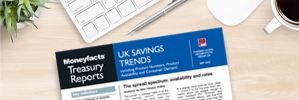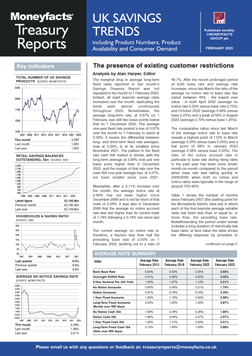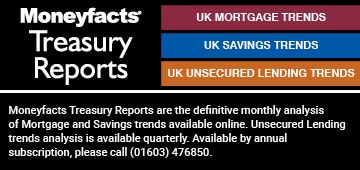Rachel Springall, Finance Expert at Moneyfacts, said:
“Savings rates rose across the market month-on-month showing positive signs of provider competition. The consecutive Bank of England base rate rises, coupled with competition among challenger banks, has led to both the average easy access and notice rates hitting their highest levels in more than 14 years. The number of accounts overall for savers has also grown, seeing its biggest month-on-month rise since March 2022 and choice now rests at the highest count since November 2022. These are all encouraging signs for the months ahead, particularly as we edge closer to a new tax-year.
“Cash ISA season has sprung a growth in product choice, which is edging closer to record-breaking levels. Savers will find the number of deals (439) is at its highest since August 2019 (453), when choice peaked. Average interest rates offered across both easy access and notice ISAs stand at their highest since 2009, but the margin between the two (0.72%) stands at its highest on record. A notice ISA may then be an alternative for savers who want a bit of flexibility, but desire a higher rate than may be on offer on an easy access ISA. Those savers who prefer to fix their ISA cash will find the average one-year fixed ISA rate stands at its highest point since January 2009 and is a notable 2.82% higher than that of a year ago. It is still imperative for savers to be conscious of their Personal Savings Allowance (PSA) in addition to their ISA allowance.
“Fixed bond rates appear to be in much demand from savers, but at the same time, there are those dipping into their more flexible pots, according to recent figures published by the Bank of England. There was an outflow of £1.2 billion from interest-bearing sight deposits in December 2022 and demand for fixed accounts recorded an inflow of almost £7 billion into time deposits. Our own data shows volatility surrounding fixed bond rates has softened after recent months of uncertainty, with the average shelf life of fixed bonds rising to its highest level since May 2022, up from 29 days to 48 days, the biggest month-on-month rise in more than two years (December 2021). However, when providers review their market positions, a standout top rate that sits way above its nearest competition may not be around for long, particularly if offered by a challenger bank that reaches it funding targets.”
Rachel Springall, Finance Expert at Moneyfacts, said:
“Savings rates rose across the market month-on-month showing positive signs of provider competition. The consecutive Bank of England base rate rises, coupled with competition among challenger banks, has led to both the average easy access and notice rates hitting their highest levels in more than 14 years. The number of accounts overall for savers has also grown, seeing its biggest month-on-month rise since March 2022 and choice now rests at the highest count since November 2022. These are all encouraging signs for the months ahead, particularly as we edge closer to a new tax-year.
“Cash ISA season has sprung a growth in product choice, which is edging closer to record-breaking levels. Savers will find the number of deals (439) is at its highest since August 2019 (453), when choice peaked. Average interest rates offered across both easy access and notice ISAs stand at their highest since 2009, but the margin between the two (0.72%) stands at its highest on record. A notice ISA may then be an alternative for savers who want a bit of flexibility, but desire a higher rate than may be on offer on an easy access ISA. Those savers who prefer to fix their ISA cash will find the average one-year fixed ISA rate stands at its highest point since January 2009 and is a notable 2.82% higher than that of a year ago. It is still imperative for savers to be conscious of their Personal Savings Allowance (PSA) in addition to their ISA allowance.
“Fixed bond rates appear to be in much demand from savers, but at the same time, there are those dipping into their more flexible pots, according to recent figures published by the Bank of England. There was an outflow of £1.2 billion from interest-bearing sight deposits in December 2022 and demand for fixed accounts recorded an inflow of almost £7 billion into time deposits. Our own data shows volatility surrounding fixed bond rates has softened after recent months of uncertainty, with the average shelf life of fixed bonds rising to its highest level since May 2022, up from 29 days to 48 days, the biggest month-on-month rise in more than two years (December 2021). However, when providers review their market positions, a standout top rate that sits way above its nearest competition may not be around for long, particularly if offered by a challenger bank that reaches it funding targets.”











